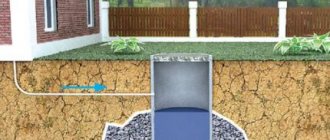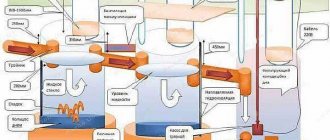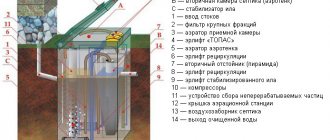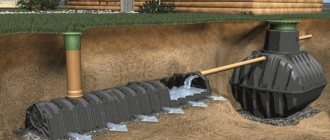Installation of concrete rings
For vertical installation of concrete rings in the ground, machine and manual methods are used; existing special equipment allows making round holes in the ground for any standard outer diameter of the well - for this purpose special drills or attachments in the form of horizontal knives are used. Homeowners who cannot afford to order special equipment often turn to the services of private craftsmen (shabashniks) who install concrete sewer wells manually.
When carrying out the work, two technologies are used: in the first case, they dig a deep hole and lower the rings into it, using a winch or holding them with their hands using ropes tied to mounting hooks. The second method consists of installing the ring on its workplace and digging out the earth from the inside, while as it deepens, the product falls down under its own weight.
In individual areas, concrete wells are usually placed after the septic tank, using them to drain (discharge) treated wastewater deep underground, therefore, before starting work, coarse-grained, fine-grained sand and crushed stone are purchased, which serve as a filter pad for the discharged wastewater. Typically, the sewage system made of reinforced concrete rings for drainage on the site has a low depth - to install it you will need two or three rings without a bottom; the top can be covered with a lid with a hatch.
Rice. 8 Support and additional reinforced concrete rings for sewerage – price list
Independent construction of a sewer well from concrete rings is carried out manually using the following technology:
- They dig a shaft of the required depth using one of the methods described above; they can be combined by digging a hole from the outside the height of one ring, and after installing it in place, then digging the ground from the inside - the element will begin to descend under its own weight. When carrying out work, be sure to monitor the vertical with a plumb line suspended from the outside or a building level. The depth of the drainage well is determined individually and depends on the labor intensity of the work carried out (the weight of the ring elements is important), financial resources, usually the number of concrete rings does not exceed three with a standard height of 890 mm, the diameter of the concrete ring is chosen 1000 or 1250 mm.
- To dig wells, it is more convenient to use products with a lock and metal ears, to which ropes are attached; after installing the first element, the ears are cut off and the next one is placed on it. When making a locking connection, no materials are placed between the rings; if the ends are flat, they are installed on a cement-sand mortar.
- After installing the concrete well, fine-grained, coarse-grained river sand (the thickness of the cushion is about 300 mm) and crushed stone (a layer of at least 400 mm) are poured onto the bottom, a hole is punched in the side wall with a perforator, an external sewer pipe is installed in it, the cracks are covered with cement mortar.
- The rings are buried under the sewer with manually raised earth, a round slab with a hatch is placed on top of the opening, which is closed with a light polymer lid.
Rice. 9 Installation of concrete rings for sewerage - main steps
Septic tank installation
Septic tank made of concrete rings in 3 wells
The number of tanks (wells) used and the number of rings for each specific house depends on the volume of wastewater coming from it. For large houses, 3 tanks are installed, two of which are sealed, and the third contains a crushed stone filter.
This is how a concrete ring septic tank works. In the first well, wastewater is received, as well as its primary sedimentation. Many anaerobic bacteria that break down organic waste in the absence of oxygen contribute to sedimentation and primary water clarification. Partially treated wastewater ends up in a second well, the purpose of which is additional filtration. It can accommodate filters made of bulk materials, mainly gravel.
The third tank is the final stage of filtration. At its unconcreted bottom there is a mixture of sand and crushed stone, through which water seeps into the surrounding soil or is used for other needs.
Features and advantages of concrete rings
The advantages of reinforced concrete circles for the construction of treatment facilities appear when compared with other materials used for these purposes:
- Tanks made of red brick require waterproofing of internal and external walls. Even with careful work, they are short-lived and are destroyed by aggressive substances present in wastewater.
- The metal is susceptible to corrosion, especially in aerobic septic tanks under the influence of oxygen. The service life of containers made of black steel is short, and stainless steel is expensive.
- The main disadvantage of plastic is its light weight. Even when filled with water, it can be squeezed out when the soil heaves. Requires anchoring to a reinforced concrete slab. Eurocubes and plastic barrels have thin walls and require protection with a metal frame to prevent them from being crushed by the soil.
- Construction of a reinforced concrete monolith is a labor-intensive and long-term process.
The area is sandy, the groundwater level is low, water is below 4 m or there is none
The combination of low groundwater level and well-draining soil are ideal conditions for constructing a septic tank made of reinforced concrete rings. Moreover, in this case, you can do without a filtration field, so the capabilities of a filter well are sufficient. There may be several design options; we have identified the simplest and most effective.
Scheme 4. 3-chamber septic tank with one hatch
Description:
- Compact 3-section septic tank with filter well.
- 1 hatch for servicing the entire system.
- Saving on additional rings - they are needed only for one well.
- Filter layer throughout the entire volume around the wells and between them.
- The bottom of 2 wells is concreted. There are no holes in the filter well, there are holes in the walls of the lower ring.
The following video shows the construction process without unnecessary comments. The main part of the work is carried out in 1 day. For increase
Conclusion:
This scheme saves space for installing external sewerage; there is no need to buy additional rings and hatches for 3 wells.
Scheme 5. 2-chamber septic tank with a filter well
Description:
- A simple diagram of a 2-chamber septic tank with a filter well.
- Can be installed and put into operation in 1 day.
- You can get by with wells made of two rings.
- The bottom of the first well is necessarily solid.
The simplified wastewater treatment scheme is due to the excellent drainage properties of the soil. In the video below, the author explains in detail the role of each structural element of the treatment plant. The video also contains a lot of food for thought, which will make you feel more confident when installing a septic tank.
Conclusion:
scheme for permanent or seasonal use. Takes up little space on the site, copes with volley discharges of wastewater. Large drainage layer resource. Pumping sludge from the first chamber no more than once a year.
Two-well scheme
The septic tank is assembled from two tanks made of concrete rings. The volume of the first tank is calculated based on the data that the decomposition of contaminants in the septic tank occurs within three days. The first tank should have a volume equal to three days' wastewater plus 20% reserve.
The volume of reinforced concrete rings is fixed for each standard size. Manufacturers indicate the internal diameter of the ring, height and wall thickness. By simple calculations, the number of required rings for a certain volume of waste is obtained, and the result is increased upward. Knowing the height of the ring, you can calculate the depth of the first reservoir. The second one is chosen of the same volume and with the same number of rings or a third less. However, the wells will have to be leveled along the upper boundary.
Important: If the depth of groundwater is less than the septic tank, then you should choose rings of a larger diameter. The bottom of the septic tank should be one meter above the aquifer.
The first well is located at a calculated distance from the house and other important objects in accordance with sanitary standards. The second well is located in close proximity to the first at a distance of no more than a meter, and even further from the house.
Diagram of the device in 2 wells. To enlarge, click on the picture.
To install wells, you should prepare a rectangular pit for both tanks at once. The depth is chosen 15-30 cm greater than the height of the rings.
A cushion of sand 15-20cm thick is formed at the bottom. It should be compacted and moistened with water to shrink.
If it is not possible to get the ring with the bottom, then a slab is placed on the bottom of the pit, preferably common to both wells. A reinforced concrete slab with a thickness of 100 mm is suitable. A single slab will allow you to install wells without the risk that they will eventually come apart or become askew, which will disrupt their connection. Otherwise, the structures will need to be tied with metal belts. It is imperative that the slab is laid strictly level.
It is best to prepare a pit and a pillow with a slab before purchasing and transporting the rings. To unload them, you will need to use a crane, and it would be better to immediately install them in their place.
It is better to choose rings with a lock and join them using a hydrophobic solution or liquid glass. The strictly vertical position of each ring is checked at all times.
The top element should be a ring with an inspection hatch; the edge of the well protrudes 10-15 cm above the soil surface. The hatches are shifted to the edge and are oriented towards the input in the first tank and in the opposite direction in the second.
A sewer pipe from the house is connected to the first well with a mandatory slope of 2-3 cm per meter. It should be laid in a trench on a sand bed. Preferably below the soil freezing level and with insulation.
To enter the septic tank, a hole is drilled in concrete rings with a diameter larger than the sewer pipe by about 10%. The input is sealed on all sides with liquid rubber, avoiding a rigid bond.
The optimal entry point into the septic tank is located at a depth of 60-70 cm from ground level. Stepping back from the edge of the input by 50 cm, a hole is drilled for the connection between the shafts, the diameter of the pipe is no less than on the route between the house and the septic tank. The counter hole on the second tank is made 1-2 cm lower. Holes for the ventilation channel are also made along the upper edge of the tanks, connecting both chambers.
On the opposite side of the connection between the tanks, holes are punched in the wall of the second shaft to connect the filter drainage system. This can be a third shaft made of concrete rings, installed on a bed of gravel and sand, or a network of drainage pipes, diverging to the sides of the well and laid in deep trenches on a layer of gravel at least 60 cm thick. The length of the drainage pipes is selected so that the volume of passing water equal to the daily volume of wastewater. A meter of drainage pipe can distribute up to 100 liters per day. The exact value is determined based on the type of soil.
Tees are installed at the entrance to the first shaft and at the outlet to the drainage system. The lower edge drops 400 mm below the entry point, and the upper edge must be accessible from the inspection hatch. This is necessary so that new effluents fall below the formed crust in the reservoir of non-distillable residues. In the second tank, so that the purest water from the middle layers flows into the drainage system.
Types of sewer rings and their scope of application
To drain sewer water, pipes are usually used that are made of polymer materials, cast iron, ceramics, asbestos cement, reinforced concrete; these products generally have a small diameter, with the exception of structures made of lightweight plastic components. If a large pipeline diameter is required for laying underground communications, the weight of long pipes becomes too large for transportation and installation of the line, so it is constructed from short rings.
Due to their low cost, wide sewer rings are made only from concrete, and this material currently has no competitors. With the development of modern technologies and the tendency to use polymers in all areas, analogs of concrete products have relatively recently appeared on the market - polymer-sand rings, which are used only for the construction of vertically installed structures.
If in the urban planning field, underground horizontal communications are laid from reinforced concrete rings for transporting organic waste, storm and gray wastewater, they are used as protection for water supply and gas pipelines, then in the household sector their use is of a different nature. In individual areas, reinforced concrete sewer rings serve as the main elements in the construction of the following structures:
Water intake wells. Installation of wells for collecting drinking water from reinforced concrete rings is one of the most popular methods of supplying water to individual residential buildings in urban and rural areas. The mine is dug manually or mechanized, after which sewer wall rings with a lock are immersed in it. If a well is made of concrete rings on the site, the depth of the structure can reach 30 m - in this case, a submersible electric pump is used to draw water.
Septic tanks. Some homeowners use sewer rings to build septic tanks or sedimentation tanks with their own hands, using structures with a closed bottom and top.
Drainage wells. Installation of reinforced concrete rings for sewerage in households is one of the most common areas of their application. Sewage water treated in individual septic tanks is disposed of on its own site, using aeration fields or drainage wells for additional purification and direction of wastewater underground. Many people install the drainage chamber with their own hands from reinforced concrete rings, installing several elements with a locking connection on top of each other in a vertical position.
Rice. 2 Engineering structures made of reinforced concrete rings
Inspection wells. Engineering structures of this type are needed for sewerage in a private house in cases where the underground pipeline has a large length or branches. To carry out cleaning, preventive work and inspection, small diameter wells are placed along the sewer pipeline. They are designed to provide access to inspection hatches installed in pipes for cleaning them in case of blockages and monitoring the condition of the line.
Caisson wells. A well made of reinforced concrete rings is often used to place pumping equipment in it, to protect a well source of water from freezing and precipitation when it is collected by a submersible electric pump or a surface pumping station. The depth of such structures usually does not exceed 2 m; during installation, they often use rings with a finished bottom or upper ceiling with a hole for a hatch; another installation option is the installation of separate round slabs for the bottom and upper manhole. Also, for caisson wells, experienced users purchase ready-made structures with built-in metal running brackets located along the entire height of the wall.
Septic tanks. Often in private households, especially in rural areas, residents who are deprived of access to a centralized sewerage system share waste disposal. They install a separate toilet for feces on the street, and gray water after washing dishes, laundry, cleaning rooms and other household needs is poured through sewer pipes into a drainage sump constructed from concrete rings.
Cellars. Concrete rings with a bottom can be used on a private plot for the construction of cellars intended for storing fruit and vegetable products deep underground in winter and summer.
Horizontal passages. When laying utilities under roads, to transfer water masses to the other side of highways and railways, large-diameter reinforced concrete rings are often used, which are simpler and easier to lay sequentially one after another than to immediately stretch a heavy long pipe.
Rice. 3 Excavation of soil for wells using special equipment
Advantages and disadvantages of a septic tank
The concrete option has many advantages, including:
- Long service life of reinforced concrete of 50–100 years;
- High installation speed;
- Autonomous operation (by definition, there are no electric pumps in the cleaning system);
- Ease of maintenance and repair;
- Extremely simple technology for installing rings on top of each other;
- High efficiency of a three-chamber treatment plant (up to 90%).
The technology of work and the design diagram are so simple that it is possible to set up an autonomous LOS of the type in question even without any experience in construction. And this is done in the shortest possible time. The sewage system in a private house will start working within a couple of days after the start of digging the earth for a septic structure.
Among the disadvantages it is worth mentioning:
- Certain difficulties in installing overflows between chambers;
- The need to use lifting equipment.
The main disadvantage of these septic tanks is the large weight of reinforced concrete products. To install them in place, you will have to order a crane. At the same time, the concrete rings themselves, despite their external solidity, are quite fragile. If, when unloading from the back of a truck, you accidentally drop one of them on its round side, it will definitely break.
Volumes of septic tanks, dimensions of concrete rings, bottoms and ceilings
According to standards, 1 person on average consumes 200 liters of water per day. The well (drainage is not taken into account) must take a three-day norm of 600 liters. To calculate the sewer volume, this number is multiplied by the number of family members to obtain the tank capacity. If there are 2 chambers, the first should receive ⅔ of the waste, the second – ⅓.
Rings are selected based on the calculated volume of the wells
Pay attention to the markings. The letters indicate the type of reinforced concrete, and the numbers indicate the dimensions in inches: first the diameter, then the height
The latter figure is predominantly 0.9 m, but with a diameter over 1.5 m it can be 60 cm to reduce weight. The diameter of the rings for a septic tank is from 0.7 to 2 m.
Decoding the markings of the reinforced concrete ring
The volume of 1 ring is calculated based on the dimensions. For example, KS10-9 has a diameter of 1 m, a height of 0.9 m, and its volume is 0.24 m³. For a two-chamber treatment plant you will need 3 elements for 1 person. If there are up to 3 people in a family, 2-3 such containers are required. The volume is increased due to the diameter, and not the number of rings - it is not recommended to install more than 3 on top of each other, since the stability of the structure is weakened.
The diameter of the bottoms is available in sizes 150, 200 and 250 cm. Installation is simplified and tightness increases if, instead of a separate element, you choose a monolithic product with a bottom. There are overlaps for all types of rings, except KS7. They have an off-center hole with a standard diameter of 0.7 m.
Carrying out calculations
You can calculate the required volume of tanks using the example of a family consisting of four people. On average, each of them consumes 200 liters of water per day, which is a total volume of 0.8 m³. If friends or relatives are visiting the house, the total discharge can reach 1.5 m³. When designing, an indicator equal to three daily volumes of wastewater is included. That is, it is necessary to lay a well with a capacity of 4.5-5.0 m³.
Next you need to decide on the rings. Their conditional capacity is calculated using a simple mathematical formula by multiplying the square of the internal radius by 3.14.
As a result, we obtain the following data for standard pipes 90 cm high with the following cross-section:
- 100 cm - 0.7 m³;
- 150 cm - 1.4 m³;
- 100 cm - 2.8 m³.
Thus, the need for rings only to collect liquid will be as follows:
- 100 cm - 7 pcs;
- 150 cm - 4 pcs;
- 100 cm - 2 pcs.
This is only the need for reinforced concrete products for the construction of the first tank.
Important! For its base, you should purchase a ring with a bottom. This solution, with a small overpayment, will save time on filling it yourself.
To build a filter well, you will need 1 more ring. The lower product will be used for filling crushed stone and sand. This is exactly how much of these materials are needed to ensure high-quality wastewater treatment.
Attention! if you use pipes of larger diameter, this will make excavation work easier and faster, since digging wide holes is much easier than narrow and deep ones. Wide shafts are easier and more convenient to maintain and clean. The only disadvantage of this solution is that several meters of usable space are taken away.
What types of septic tanks can be built from concrete rings
Concrete rings allow you to independently build a septic tank of any capacity and degree of wastewater treatment. The simplest option is a sump storage tank. It is a single sealed container in which liquid simply accumulates and needs to be pumped out frequently. The volume of this container is adjusted by the number of rings used.
Standard concrete rings come in diameters of 100, 150 and 200 cm. The height of the rings varies, but most often they use rings with a height of 0.9 m. Accordingly, to calculate the volume of one element, you need to multiply the height by the square of the radius of the inner circle and the number P equal to approximately 3.14. Those who are too lazy to do the calculations can remember that a meter ring gives a volume of about 0.7 m³, a one and a half meter ring gives about 1.5 m³, and a two meter ring gives a little more than 3 m³.
An example of placing a septic tank in the ground
The second option assumes the presence of two cameras. In the first, wastewater settles and denser substances settle to the bottom. Liquid flows into the second chamber according to the principle of communicating vessels. The bottom of the second chamber is not sealed, and there is drainage underneath it. For this reason, the liquid goes into the ground. The first chamber is usually made somewhat smaller in volume.
Local treatment plant using concrete rings
The third do-it-yourself septic tank design made from concrete rings involves better wastewater treatment. It has three cameras. In the second, suspended particles also settle, and in the third, water goes into the ground. This scheme cleans wastewater more reliably, but at the same time is more cumbersome.
Diagram of a septic tank with two wells made of concrete rings
Calculation of capacity and choice of septic tank design
The volume of wastewater is a basic value taken into account when designing any treatment facility. Sanitary standards set it at 200 l/day per person. In addition, the capacity of the septic tank should be equal to the 3-day volume of sewage. Based on these two conditions, the capacity of the structure can be calculated. So, for example, a family of 4 people will need a septic tank with a volume of: 4 x 200 l/person x 3 = 2,400 l. (2.4m3).
The second issue that needs to be resolved is the number of cleaning chambers: one, two or three. If no more than 3 people permanently live at the dacha, then you can limit yourself to one camera.
With a larger number of residents (4-6 people), the sewage system in the dacha is made of concrete rings and is made of two chambers. It copes better with large sewer flows. Three cleaning tanks are used in houses where several families live.
Each septic tank chamber performs certain tasks:
- In the first, sedimentation of wastewater and anaerobic (oxygen-free) decomposition of organic matter occurs. Heavy particles settle to the bottom here, and light particles float to the top. Clarified water flows through the pipe into the second chamber;
- In the second tank, the wastewater undergoes additional bacterial purification and is discharged into a filter trench or well. Oxygen (aerobic) decomposition of organic matter occurs here.
The choice of filtration method depends on the groundwater level and type of soil. In a resorption well, water goes into the ground through perforated walls and a bottom covered with small crushed stone.
Two-chamber septic tank made of reinforced concrete rings with a filter well
When the level of soil water is high and the soil does not absorb moisture well (clay, loam), a resorption trench (filtration field) is made. A perforated pipe wrapped in geotextile is placed in it and covered with drainage material (crushed stone, gravel + sand). Due to the long length of the pipe and the presence of a filter bed, the final cleaning process proceeds normally even in heavy and wet soil.
Three-chamber septic tank with filter trench
Having determined the capacity, the number of chambers and the type of filtration structure, you can proceed to choosing a location on the site. The diagram will help you in this matter. It indicates the minimum permissible distances from the treatment plant to water sources, trees and roads.
Sanitary gaps between the septic tank, water source and other objects
From this diagram it can be seen that the greatest distance of the sewerage structure should be from the source of drinking water (50 meters). On a dacha plot of 5 acres, this requirement is impossible to fulfill. Here you will have to install a device for disinfecting drinking water with an ultraviolet lamp or use imported bottled water.
In addition to observing sanitary gaps, the septic tank must be placed so that its chambers can be reached with the hose of a sewer truck.
Concrete rings for sewerage
When manufacturing concrete sewer rings, they are guided by sections of GOST 8020-90, which regulate the technical conditions for this type of product. Its main provisions include the following points useful for specialists and ordinary consumers:
- The structures are made from heavy concrete in accordance with GOST-26633 with a compressive strength of 70% of its grade or class.
- For reinforcement, rod reinforcing wire, thermomechanically hardened or hot-rolled steel are used.
- Well rings must comply with the requirements of GOST 13015-2012, which regulate their parameters according to the following indicators:
- rigidity, strength and crack resistance of structures without load;
- physical strength of concrete in its original finished form, and tempering strength after manufacturing the product;
- waterproof and frost-resistant;
- thickness of the concrete layer to the built-in reinforcement;
- grades of steel for fittings, running and loop fillings.
Rice. 4 Concrete rings for sewerage - dimensions according to GOST 8020-90
Concrete rings and auxiliary structures have symbols consisting of the following sequence of alphabetic and numeric symbols with the explanation below:
1. – indication of the serial number of the standard size (1, 2, 3 and so on), quite often the first digit is missing in the designation;
2. – type of reinforced concrete structure:
- KS - a wall ring of a chamber or the neck of a structure, if a narrow manhole of some height with a hatch is installed to access the working chamber;
- KO - support ring, installed on the top plate of the structure to construct a neck under the hatch, through which access to the inside of the working chamber is provided. Differs from the wall type in its low height, larger wall thickness and fixed diameter;
- PN – bottom plate, placed under the well bottom;
- PP – floor slab, installed on top of the structure, has a rectangular or round cutout for mounting a manhole with a hatch;
3. figure: for KO and KS - the internal diameter in decimeters, in the designations PN and PP - the internal diameter of the well rings on (under) which they are placed;
4. – the digital symbol after the dot indicates the height of the wall reinforced concrete products in decimeters.
Rice. 5 Parameters of support rings KO and plates PO, PN according to GOST 8020-90
Excavation
foundation pit
You will have to dig a pit large enough, since it must contain both cleaning chambers and a well for filtration. Therefore, it is advisable to entrust this work to special equipment, for example, a mini-excavator, which will significantly save time.
Manual digging of such a hole is not an easy task, and it is only rational if there are strict cost savings, the inability to rent equipment and the availability of free hands and time.
Untreated wastewater must not be allowed to seep into the ground, so it is necessary to construct a concrete base in the area where the sump is installed. A sand cushion with a layer of 40-50 cm can act as a drainage system.
The base of the filtration well also needs to be strengthened. The best option for this is a cushion of several layers of sand, gravel and crushed stone with a depth of at least 50 cm.
Construction and operation of a septic tank made of rings
In order for a self-made septic tank made of concrete rings to carry out the cleaning process effectively, it must accommodate three times the daily water consumption of one person.
That is, in three days one person consumes approximately 600 liters of water, which means that if a family consists of three people, then a septic tank with a volume of 1800 liters will be required.
Wastewater flows through a pipe that runs from a private house into the first tank, settles, and splits into ordinary liquid and sediment, which in turn must be removed every couple of years if the treatment plant is done correctly.
The second tank is also sealed (if there are only three of them), so liquid from the first tank flows here when it reaches the level of the overflow pipe.
In the second tank, the decomposition process occurs; for this, a ventilation hole is built into it, through which methane evaporates, the remaining part precipitates in the form of sludge.
From the third reservoir, the purified liquid enters the ground if the treatment facility made of concrete rings is equipped with a drainage bottom, or is pumped out if it is an ordinary well.
Septic tank location
Thus, a septic tank made of concrete rings is intended not only for the accumulation of wastewater, but also for its purification and discharge into the soil, which is really convenient for a summer house or private house and does not require regular pumping over a short period.
It is also necessary to carefully consider the location of the septic tank.
The following recommendations should be considered:
- the septic tank should be located at a distance of 5-20 m from the house;
- it is necessary to be able to drive up to the septic tank with a pumping machine or special equipment during its installation;
- you should figure out what the level of groundwater is in the selected area, check seasonal fluctuations;
- if there is a well with clean water on the site, then there should be at least 30 m from the well to the septic tank.
In order for the concrete rings to fit tightly together, you should buy them with locks.
Installation of a septic tank made of concrete rings
Let's consider the process of installing a septic tank made of concrete rings.
- First, you need to dig a pit using an excavator, but take into account the fact that when digging a septic tank, its size must be calculated in such a way that people can work freely between the pit wall and the concrete rings during the installation process.
- Sand should be poured into a layer of about 20 cm at the bottom of the septic tank.
- If rings without a bottom were purchased, then you need to concrete the place in the pit where they will be located.
- Next, using a crane, the concrete rings are installed, and the top is covered with a lid.
- Be sure to waterproof the joints between the concrete rings and between the lower ring and the concrete base. If concrete rings with a bottom are installed, waterproofing is carried out only between the joints.
- Then the pipes are laid. The septic tank is also waterproofed between the pipe and the wall of the tank.
- The septic tank is waterproofed along the outside of the installation, then the pit is filled up.
In this case, they roll it without the help of special equipment to the selected area and dig up the ground underneath it so that in the future it will lower itself into the dug pit.
What types of septic tanks are there?
Today there is a wide variety of septic tanks, but a septic tank made of concrete rings has the advantage of affordable cost. There are several types of septic tanks made of concrete rings on the market:
1) single-chamber septic tank made of concrete rings. They install only one camera 5 meters from a country house. In the future, such a septic tank will require regular pumping of liquid, so it is necessary to provide convenient access for the car to the installation;
2) two-chamber septic tank for a bathhouse. Such a septic tank consists of several tanks, since wastewater that has undergone effective treatment can be used for irrigation;
3) overflow septic tank. Its distinctive feature is that each container is installed at a level lower than the previous one. This type of septic tank is the most effective and will last for many years.
You should take into account the fact that the work of a single-chamber septic tank is not of sufficient quality and durability, so it is better to install at least a two-chamber septic tank made of concrete rings, from which the liquid can be used for economic purposes (for example, watering a garden).
Preparatory stage
Before making a septic tank from reinforced concrete (RC) rings, it is necessary to carry out preparatory work. It will be necessary to calculate the volume of the chambers, then a diagram of the septic tank from concrete rings must be drawn up. Then choose a good place for construction, as well as purchase the necessary materials.
Calculation of chamber volume
A septic tank made of concrete rings must have sufficient volume. This device works effectively if the wastewater is left in the chambers for a long enough time. To correctly calculate the volume of the chambers, you need to know how much water the residents of a private house use per day. According to the standards, the installation chamber must accommodate the volume of wastewater that is generated in the house over three days.
But how to calculate and find out how much water is consumed by the inhabitants of the house? To calculate the volume of the chambers, it is worth considering that each resident uses approximately 200-250 liters of water per day. Thus, the calculation of daily consumption is carried out according to the formula: water consumption is multiplied by the number of residents of a private house.
Advice! When making calculations, you need to take into account the number of plumbing fixtures in the house. For example, if you plan to build a sauna with a swimming pool, then you need to increase the volume of the chambers taking into account this circumstance.
Drawing up a diagram
After the volume of the chambers has been calculated, you can begin to draw up a diagram of the septic tank for a private home. First of all, you need to decide how many chambers the installation will have, it depends on the amount of waste processed:
- If no more than a cubic meter of water is consumed in the house, then it is recommended to build a homemade single-chamber septic tank;
- If the water flow is from 1 to 10 cubic meters, then you need to build a two-chamber septic tank from concrete rings;
- If the water consumption is more than 10 cubic meters, it is necessary to plan the manufacture of an installation consisting of three chambers, settling tanks and a filtration well.
Choosing a location for installation
In order for septic tanks assembled from reinforced concrete rings to work efficiently and not cause inconvenience to the owners of the house and their neighbors, it is necessary to choose the construction site wisely:
- it cannot be placed close to the house, the distance must be at least five meters, and other buildings (for example, a garage) - a meter;
- It is necessary to locate the installation as far as possible from the source of drinking water. Minimum distance – 50 meters;
Where to buy materials?
Before you start building septic tanks from rings, you need to purchase materials for making chambers. Well rings have standard sizes and, accordingly, standard volume.
The height of the rings is, as a rule, 1 meter, but their diameter can vary. You need to choose the sizes of the rings taking into account what dimensions, according to calculations, the cameras should have.
How to choose a place for a septic tank made of turnkey concrete rings
Before wastewater penetrates into the ground, it must be cleaned and neutralized. This is the purpose of the treatment plant.
Here, the organic component of fecal and sewage accumulations is separated into safe sludge and water suitable for irrigation of the territory. The septic tank as such does not affect its contents, but it creates conditions in which bacteria develop, decomposing organic matter into safe elements.
In addition to compliance with the regulations of this document, you need to obtain a hygienic certificate, which gives the right to install a treatment station in the selected location, as mentioned in SanPiN 2.1.5.980-00.
According to these documents, a proper septic tank made of concrete rings must be built at least 50 m from the borehole or well shaft, and the discharge of water from the septic tank must be at a distance of at least 30 m.
The septic tank should be installed at least 4 m from the house and water pipes near it, and at least 5 m from the road. To build a septic tank in a chosen location, you need to contact the sanitary and epidemiological station or the district administration for a permit for construction work and a certificate.
You can build a septic tank without coordinating the construction with the local administration. However, if violations of legal requirements are detected, fines will not be long in coming, as will the requirements to move the capital structure to another location.
Calculation of a septic tank made of concrete rings - we calculate the volume and productivity
In order for the wastewater to be completely cleaned, it must lie in the treatment plant for at least three days. Therefore, the volume of each section of the septic tank is calculated as:
V = 3*Y*Z
Here: V is the volume of a separate section of the septic tank, Y is the rate of water consumption by one person (conditional), Z is the maximum number of people living in the house.
Septic tanks installed in accordance with this formula are very large, but they provide maximum purification of fecal and sewage wastewater, turning it into water suitable for irrigation of the site and sludge that serves as fertilizer. The rate of water consumption is determined by many parameters.
Indoor water supply and sewerage systems in buildings meet the conventional norm of 95–300 liters per person per day.
You can calculate on your own how much water you consume, or use the SNiP table.
When thinking about installing a septic tank made of concrete rings, it is better to adhere to the maximum values and increase the number of residents by 50%. Although this will increase the cost of building a septic tank, you will eliminate the risks: if guests arrive, the septic tank will not overflow and the ground near the building will not be flooded with feces.
With this approach, construction costs are significantly reduced, and the degree of wastewater treatment becomes worse as the number of residents increases.
If purified water is supposed to be discharged close to buildings and water intake points (up to 50 m), use the formula in relation to the volume of one section.
If the distance is greater than 50m, you can use the formula for the total volume. Untreated wastewater removed at such a distance will not be dangerous.
Types of septic tanks made of concrete rings
Several types of septic tanks are built from reinforced concrete rings, and the stations differ:
- depth level;
- ring diameter;
- insulation.
The depth of the septic tank is determined both by its dimensions and winter temperatures, more precisely, by the depth of soil freezing.
The lower it is, the lower the septic tank needs to be installed, since a strong drop in temperature (less than zero degrees) slows down or even stops the processes occurring in each section. Therefore, it is necessary to either deeply bury the septic tank - all its sections, or insulate each section with polystyrene foam or similar insulation.
You can reduce the cost of installing concrete rings under the septic tank if the station is deeper if you install not reinforced concrete rings above the freezing depth of the soil, but a brick well, since above the freezing depth of the soil the processes in the septic tank are greatly inhibited even with high-quality insulation.
Septic tanks are also classified according to the number of their elements. Single-element ones are called cesspools and are considered ineffective.
The most effective designs are made of three elements. A larger number of sections does not affect the quality of wastewater treatment. Three sections can be placed in the longitudinal direction, in which case the installation is very long, or in a triangle, when the area of the pit for the septic tank is reduced by almost a third, and with it the volume of soil that needs to be dug.
Technology for installing a treatment structure made of concrete rings
Work on arranging a durable and reliable septic tank from rings is not a complex undertaking. You can do them yourself. If the arrangement of several chambers is designed, a linear principle is used, in which concrete columns assembled from rings are placed along one line.
After the receiving compartment on the septic tank overflow diagram from the rings there are tanks installed in close proximity to each other. A filter column is installed at a considerable distance from them.
The step-by-step work to create a treatment facility on a personal plot is as follows:
- Carrying out measurements and design.
- Preparation and acquisition of necessary materials.
- Digging a pit and creating a cushion.
- Installation of concrete rings and insulation of seams.
- Installation of overflow pipes.
Basic information
Postulate 1. Position correctly
Choose a place for the septic tank on the highest area of the site. This is necessary so that stormwater does not flow into it.
For the placement of the septic tank, see SP 32.13330.2012, the distances to it should be as follows:
- from the house – 5 m;
- from the reservoir – 30 m;
- from the river – 10 m;
- from the well – 50 m;
- from the road – 5 m;
- from the fence – 3 m;
- from the well – 25 m;
- from trees – 3 m
Postulate 2. Look at the groundwater level
If the groundwater level (GWL) is high, i.e. water accumulates in the pit already at a depth of 1-1.5 m, then this is a reason to think about choosing a different septic tank design, possibly a plastic septic tank or a biological treatment station. We described in detail about ready-made VOC options in this article.
If you have firmly settled on wells, then you should wait until the groundwater level is lower. For example, in summer or winter. This will simplify the development of the pit and the construction of wells: you will not stand knee-deep in water and will be able to properly concrete the bottom and seal the seams between the rings.
Postulate 3. Calculate the volume of the septic tank with a margin
Carefully calculate the volume of the septic tank. Please note that the rule according to SP 32.13330.2012, in which the volume must be greater than 3 times the volume of wastewater discharged into the sewer per day, is valid only on sandy soils and at low groundwater levels. The rules assume that 1 person per day will discharge 200 liters of wastewater. This means that in this case you need a septic tank with a volume of 600 liters.
In other cases, the worse the soil drains, the larger the volume of the septic tank.
There is a working rule: for a family of 4-5 people with permanent residence, depending on the soil, the septic tank will be 30 m³ - on clay, 25 m³ - on loam, 20 m³ - on sandy loam, 15 m³ - on sand. Calculation of septic tank volume
| Number of people | Septic tank volume, m³ (working values) | |||
| Sand | Sandy loam | Loam | Clay | |
| 1 | 4 | 7 | 10 | 15 |
| 2 | 7 | 12 | 17 | 22 |
| 3 | 10 | 15 | 20 | 25 |
| 4 | 15 | 20 | 25 | 30 |
| 5 | 15 | 20 | 25 | 30 |
| 6 | 17 | 23 | 27 | 35 |
| 7 | 20 | 25 | 30 | 35 |
It is necessary to vary the volume of the septic tank not by the depth of the wells, but by the diameter of the rings. Those. if you have a choice of rings with a diameter of 1.5 m and a height of 0.9 m, or a diameter of 1 m and a height of 0.9 m, then it is better to take the former. Fewer quantities will be required to obtain the required volume. This means that a pit will not be as deep and there will be fewer seams in the wells.
Postulate 4. Hire people to develop a pit
If you are not a 20-year-old young man, and you do not have a couple of similar assistants ready to work for barbecue and beer, then entrust all excavation work to hired workers or hire an excavator.
The pit must be larger than the volume of the treatment plant, i.e. the distance from the wells to the walls of the pit is 30-50 cm. Subsequently, this volume must be filled with sand and gravel mixture (SGM) or sand.
Postulate 5. Order rings with delivery and installation
Order rings only after the foundation pit is ready. Immediately with installation, i.e. a truck with a crane should arrive.
All lower rings must have a bottom. They are available in a factory version - convenient and reliable. The exception is filter wells, which are made on well-draining soils. But under no circumstances should you do this
like the picture below!
After 1-2 years, the bottom of the filter well silts up and does not allow drainage to pass through; you have to call a sewer truck to clean the well, but this does not provide a long-term effect.
Postulate 6. Use only red pipes
Pipes are only red, with a diameter of 110 mm, for external sewerage. They need to be insulated only if in some area they are located in the open air. Anything in the ground does not need to be insulated.
Red pipes are specially designed for external sewerage. They are multi-layered and can withstand soil pressure. Gray pipes are intended for work inside the house; they are single-layer and the soil will simply crush them.
The pipes are laid in trenches on a compacted sand bed with a slope of 2 cm by 1 m. Avoid turns of 90 degrees, maximum 45. A layer of ASG or crushed stone 30 cm thick is poured on top and on the sides. Next is soil.
Postulate 7. The filtration field occupies a large area
A filtration field is needed at high groundwater levels; at low water levels, a filter well can be used. On average, expect that the drainage field area should be at least 10 m² per person.
It is appropriate to make a filtration well on well-draining soils: sand and sandy loam. On clay and loam, significantly larger areas are needed from which drainage will be carried out. Underground filtration fields allow this to be done.
Pipes on the filtration field must be laid with a slope of 1 cm by 1 m so that the treated wastewater has time to seep through the holes into the crushed stone layer.
Taking measurements and designing
To ensure effective wastewater treatment, it is necessary to create conditions under which they can remain inside the storage tank for three days. For this reason, the volume of a septic tank made of concrete rings is determined taking into account the total three-day volume of wastewater.
Water consumption in accordance with daily consumption standards for one family member when using household appliances is about 200 liters. By simple calculation it can be determined that for a family consisting of 2 - 3 people, the minimum volume of a treatment plant should be approximately 2 cubic meters.
But for a cottage where 5 - 6 household members permanently live, the construction of a structure capable of accommodating 3 - 4 cubic meters is required. When determining the volume of a septic tank, experts advise making a small reserve, since if strangers arrive, there is a risk that the norm will be exceeded. To eliminate the consequences of incorrect calculations, significant financial costs will be incurred.
When deciding which rings to make a septic tank from, and how many of them are required, you need to take into account that the actual volume must exceed the calculated values. This is because as the tank fills, the wastewater rises to the location of the overflow holes - it never reaches the top edge. For this reason, the calculated volume of waste liquid should only reach the level of these pipes.
How does a sewerage scheme work?
Regardless of the number of containers, septic tanks work the same. Once in the first chamber, the wastewater is divided into heavy fractions, which settle to the bottom, and light fractions, which remain on top. Mechanical cleaning is complemented by the activity of anaerobes, which convert organic matter into gases. They escape into the atmosphere through the drain pipe of the internal sewage system or the ventilation riser in the septic tank.
A fatty film forms on top. To prevent it from getting into the next chamber, a tee is installed on the overflow, which is lowered into the drains below the film. There may not be a second tank, then the wastewater purified by gravity and anaerobic methods is discharged to filtration facilities, where post-treatment occurs. Such structures are common among summer residents who come only on weekends. But it should be borne in mind that a single-chamber septic tank quickly silts up and needs to be cleaned more often.
The processes in the second chamber do not differ from those that occurred in the storage chamber. Here, the pre-treated wastewater becomes even lighter. Silt falls to the bottom, and the remaining organic matter is processed by anaerobes. Then the water is sent by gravity for additional filtration or goes into an aerobic septic tank. This is where the final cleaning takes place.
Selecting a location for a treatment plant
When designing a septic tank, the sanitary zone is placed so that organic waste cannot penetrate into the fertile soil and source of drinking water. For this reason, you need to adhere to the relevant building codes regulating how to properly make a septic tank from rings or other building materials.
The wastewater treatment system in a suburban area is equipped taking into account the following provisions:
- SNiPa 2.04.03.85 - it reflects the rules for the construction of external sewerage facilities;
- SanPiN 2.2.1/2.1.1.1200-03 - this document lists the requirements that should be met when creating zones considered environmentally unsafe.
According to these standards, to prevent the foundation of the house from getting wet due to emergency leaks, the septic tank must be placed so that it is lower than the residential building.
When choosing a location, be sure to take into account the presence of natural reservoirs with running water. The distance to them that must be maintained cannot be less than 5 meters. In this case, the gap to the trees should be 3 meters, and to the bushes - about a meter. The distance of the septic tank from the house is also important, which is better to increase, but not decrease.
It is also necessary to find out where the gas pipeline runs under the surface of the earth. It is necessary that the distance to it be at least 5 meters. But it should be borne in mind that it is prohibited to place vehicles above the place where the treatment structure is planned to be buried, since their weight can destroy the entire structure.
Types of concrete rings
The rings differ in the type of construction:
The final structural element of a reinforced concrete septic tank
- With a bottom. A monolithic product, which is installed first in the pit, with wall walls on top. Used to create a sealed container, leaks do not occur during the entire period of operation. Standard height is 0.9 m.
- Castle ones. With special recesses in the upper and lower parts. During installation, a reliable connection occurs. Indispensable for the construction of septic tanks on floating soils.
- With lid. There is a hole in the ceiling for a hatch. This is the final element of the well. The monolithic product increases the strength of the entire structure.
Advantages of septic tanks made from rings
Septic tanks made from concrete rings have a number of advantages, not because we install them, but because they really meet all the customer’s expectations. These septic tanks, installed by us 10 years ago, still serve their owners well and do not cause any discomfort both during temporary and permanent residence in the house. Let us list the main advantages that concrete septic tanks have:
Affordable cost - prices for concrete rings have always been low since their inception, that is, adequate in comparison with other materials. Reinforced concrete rings are the main component of a septic tank made of rings, therefore the total cost of installation will be inexpensive; Strength and durability - the guaranteed minimum service life of a septic tank is 50 years! No other septic tank will provide such a guarantee, and this is even in the absence of additional treatment of the rings; Doesn’t float up - many are already familiar with the problem when, in the spring, their septic tank simply floated up. The specific gravity of a septic tank made of concrete rings is simply enormous and rising from the ground is simply impossible. It won’t burst - the natural soil pressure on the septic tank is not visible to humans, but it is there
Many modern septic tanks cannot withstand it, which is not at all scary for a septic tank made of reinforced concrete rings; Installation in any soil - it doesn’t matter what kind of soil is on your site, sand or clay, even in an open swamp the septic tank will feel good. No electricity is needed - yes, while all modern plastic septic tanks require direct current to operate, concrete ones operate autonomously and without electricity. An important point for those who have problems with frequent power outages. Installation in 1 day - yes, we can install any of the septic tank options proposed above and start it up in just 1 day! Low maintenance - no need to constantly clean or check it
Such a septic tank can be pumped out once every 2-3 years. Installing a septic tank at any time of the year - there are no restrictions on time of year or weather. We install ring septic tanks in winter, summer, autumn and spring in any weather. Choice of volume – we can make a septic tank of the required volume depending on the number of permanent residents in the house. This allows you to choose the best option and save on unnecessary volume.
Before making a choice in favor of one or another septic tank, read again the advantages that we have written. Perhaps you have not yet lived in your home where there is no central sewerage system and you think that any septic tank works the same. They really can work the same way, but not all of them can serve without failures and problems. We have described those advantages that can really be highlighted as fundamental when choosing an autonomous sewage system for a private home.
Options for creating a structure
Installing a septic tank from reinforced concrete products is not considered too difficult a job. It may have a two- or three-chamber design. Regardless of the type of design, in the process of servicing it, you need to seek the services of vacuum cleaners and order special equipment to remove solid waste that collects on the internal surfaces of the tank.
A single-chamber septic tank made of rings is a storage tank that operates on the principle of a cesspool; it is equipped much less frequently. Property owners give preference to these designs when it is necessary to equip a sewer system for small-sized country houses in which the owners live in the summer or during vacation, provided that the volume of wastewater is insignificant.
Another important reason for choosing a single-chamber storage tank is the high level of groundwater, as well as the predominance of clayey rocks in the geology of the territory.
A septic tank with two wells or three chambers is installed when creating autonomous treatment facilities for country houses, which are intended for permanent residence, when the planned volume of waste liquid is large.
In the process of arranging a two-chamber structure, if it is supplemented with a filtration field or a filter well, the first chamber is a sealed container with a limited amount of oxygen. It must be equipped with a concrete or cast iron hatch, a supply and drainage line. The second compartment is equipped with a ventilation pipe to ensure oxygen access.
In a sewerage scheme made of concrete rings, consisting of two or three tanks, wastewater is subjected to multi-stage treatment by settling and filtration:
- In the first storage tank, a pre-cleaning process occurs, during which large suspensions settle and, in conditions of lack of oxygen, undergo decomposition, and anaerobic bacteria process organic matter. In the second tank, the purification and filtration process continues, but aerobic bacteria and oxygen are already involved.
- Decomposed organic residues, which look like sludge, sink to the bottom, and clarified waste flows into a drainage well, which is also called a filter or absorption well.
From there, through holes in the walls, the purified water is filtered through a sand-crushed stone layer and sent into the soil. When a personal plot is located on soils that have sufficient filtration properties and are well absorbent and permeable to liquid, and the level of groundwater is low, it is better to give preference to the option of installing a septic tank, in which the clarified liquid is redirected to the absorption compartment.
On soil with a depth of underground water layers reaching only 2.5 meters, the cleaning process becomes impossible, since there must be at least one meter between the lowest point of the drainage well for a septic tank made of concrete rings and groundwater.
In this situation, it would be better to drain the treated wastewater to drainage fields. But the arrangement of such systems requires a large area of land.











